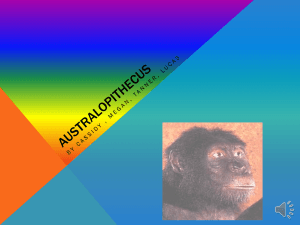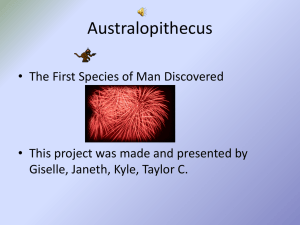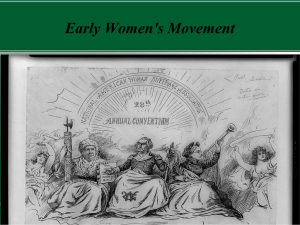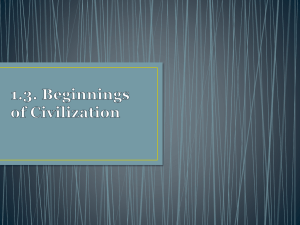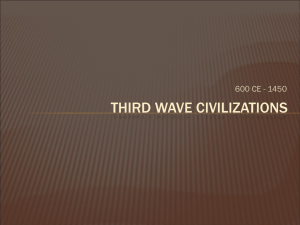Australopithecus-by-Julian-Diana-Nikolas
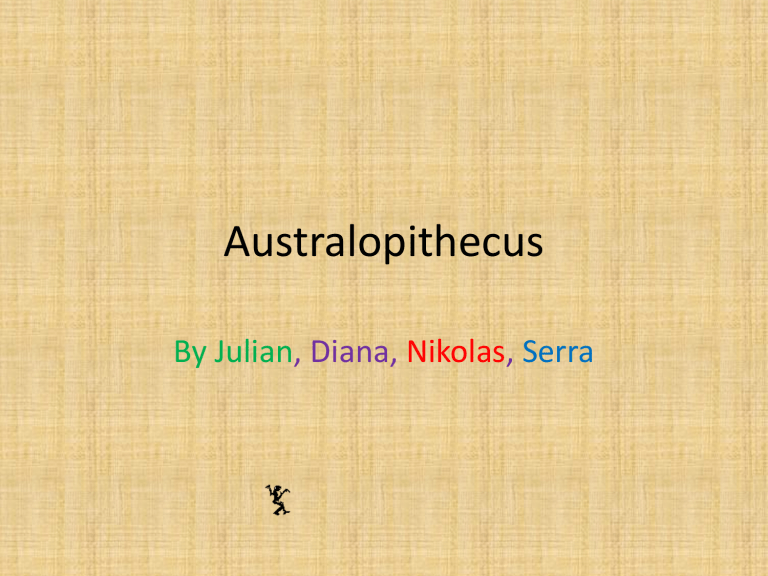
Australopithecus
By Julian , Diana, Nikolas , Serra
Introductory Slide
Take a trip with us back in time to explore the world before electronic technology and devices.
Discover how the Australopithecus lived millions of years ago. Learn what they ate, where they lived, how they lived, and what they looked like.
So come on a journey into the past and explore the daily life of an Australopithecus.
Dates and Places
• The Australopithecus lived about five million years ago. They commonly lived in Southern and Eastern Africa.[1]
Appearances
• The Australopithecus were dramatically hairy.
They were forty-seven to sixty-seven inches tall, and they walked upright on two feet. The average weight of a male Australopithecus was about ninety to one hundred fifty-four pounds, and the female Australopithecus weighed about fifty-five to sixty-six pounds.[2]
Shelters
• The Australopithecus would commonly live in the open, finding shelter in tall trees to stay out of sight from large predators and other
Australopithecus tribes.[3]
Food
• Australopithecus ate animals they hunted or dead animals they found while hunting.
Primarily, they were scavengers. In addition to eating animals, they would also look for bird eggs, fruit, roots, leaves, insects, and several other types of plants.[4]
Daily Life
• The Australopithecus would mainly spend their lives trying to survive. So by doing that, they would be mainly hunting for their tribe and trying to stay alive.[5]
Tools
• Australopithecus did not invent. Instead, they used natural resources like things that have already been formed. For example, sticks and stones would have been used as tools, but they were not modified in any way by
Australopithecus.[6]
Fire
• The Australopithecus did not discover fire because their lives were very difficult, and they were mainly to occupied trying to survive.[7]
Religion and Ceremonies
• Australopithecus had neither religion nor ceremonies because they were too occupied trying to find food and shelter and to survive their harsh lives.[8]
Language
• The Australopithecus did not have exact language, but they would use hand gestures and sounds. They did not have a specific type of language.[9]
Clothing
• The Australopithecus did not wear or make clothes, but they might drape animals skins over themselves when it was particularly cold since they had no fire.[10]
Painting and Carvings
• The Australopithecus did not have the time to paint and carve because they were too busy trying to survive and stay alive.[11]
Lucy
• Lucy was an Australopithecus who died, possibly by drowning in a river about 3.8 to 3.2 million years ago. She was found in 1974 by Donald
Johanson and his team of archaeologists. Lucy was three feet eight inches tall and weighed about sixty pounds. Lucy’s name was chosen because the archaeologists were listening to the song “Lucy in the Sky with Diamonds,” by the
Beatles, when they discovered the skeleton.
People suggested that the skeleton be named
Lucy, and so the name stuck.[12]
Questions
• What type of tools did the Australopithecus use? Explain.
• Who was Lucy?
• How did the Australopithecus speak?
Answers
• Australopithecus did not invent tools. Instead, they used natural resources like things that have already been formed, for example sticks and stones.
• Lucy was an Australopithecus who died, possibly by drowning in a river about 3.8 to 3.2 million years ago.
• Australopithecus did not have exact language, but they would use hand gestures and sounds. They did not have a specific language.[9]
Conclusion
• Woo, what a trip. Now that you've learned a lot about the Australopithecus, we can travel back in our own time and enjoy the knowledge that we have discovered. We hope you learned a lot about the life of
Australopithecus and what they did to stay alive!
End Notes
1.
California Vistas Ancient Civilizations, Macmillian/ McGraw-Hill: New
York, NY, 2007, pp.64-67.
2.
Ibid.
3.
www. Ecotao.com./hoslim/hu_austral.htm 2008.
4 Early humans packet.
5. www. Ecotao. com /hoslim/hu_austral.htm 2008
6. johnhawks. Net/… / dikikia-cutmarks-mcpherron-2010. html
7. Interview with Ricky Rivera.
8. California Vistas Ancient Civilizations, Macmillian/ McGraw-Hill: New
York, NY, 2007, pp.64-67.
9. Ibid.
10. www. Ecotao.com./hoslim/hu_austral.htm 2008.
11. Ibid.
12. California Vistas Ancient Civilizations, Macmillian/ McGraw-Hill: New
York, NY, 2007, pp.64-67.
Bibliography
• California Vistas Ancient Civilizations.
Macmillian/ McGraw-Hill: New York, NY,
2007.
• Kearns, Marsha.“Homo Habilis.” Early
Humans. Creative Teaching Press: CA,
1993.
• www. Ecotao.com./hoslim/hu_austral.htm
2008.
